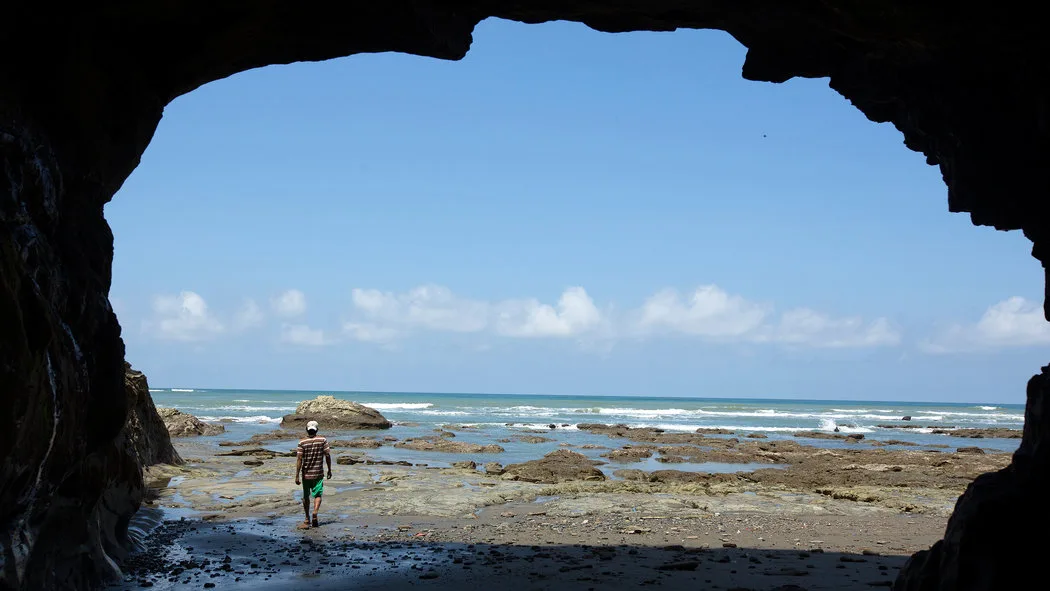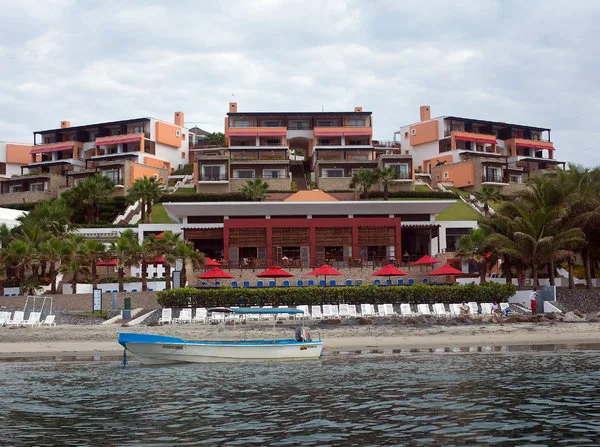Often overlooked, Ecuador’s north coast offers up plenty of treasure
By Geoff Bendeck
Reggaeton blaring, we zoomed along the coast of Esmeraldas, past a series of resort towns, white sand beaches spoiled only by concrete hotel towers. Our Ranchera, an Ecuadorean open-air bus, paused just long enough for schoolchildren to climb atop the roof before we veered slightly inland away from the jagged, rocky coast and into the remnants of a jungle canopy.
The bus dropped me at Playa Escondida, a private nature reserve and hotel, halfway between
the small towns of Tonchigüe and Galera. At low tide the beach exposed large honeycomb tide pools extending over half a mile out to sea. A local man and woman jumped from rock to rock, searching among the crags and nooks of the exposed reef for clams and lobsters.
It was a typically low-key scene in Esmeraldas, an Afro-Ecuadorean province nestled in the far northwest corner of the country, a seductive mix of rugged jungles, giant mangroves and coconut-lined beaches. According to popular myth the first Afro-Ecuadorean arrived aboard a mutinied slave ship in 1553. The former slaves intermarried with the indigenous tribes that lived along the lush, wide rivers of the land — remnants of the once mighty La Tolita culture — and formed the equally mighty Zambo Republic.
Today, Ecuador is attracting retirees by the thousands to places like Salinas and Cuenca, gems of the country’s safe, known world. But visitors to Ecuador often overlook the Emerald Coast, home to some of its last wild beaches. And several renovated “green” eco-resorts are intent on preserving the area’s beauty and mellow charms.
Checking into the lodge, I found Judith Barett supervising the construction of a new reception building for the property. Ms. Barett, the Canadian owner of Playa Escondida Ecological Refuge and Lodge, discovered the hidden beach nearly 40 years ago while on a camping trip with a boyfriend. Slowly, over the last 15 years, she has overseen the transformation of the quiet cove. “This was always a quiet camping site. No one ever knew there was a beach here,” she said. “One day we found trash and remnants of campfires. We found out it was shrimp farmers from Manabí. It was obvious they would turn this place into a shrimp farm if I didn’t buy it.”
My cabin at Playa Escondida was rustic but charming. A stairway led from a stone path to the second floor of the hardwood and bamboo structure where my bed, protected by a mosquito net, occupied the center of the open-air platform. I awoke each morning with a near
360-degree view of the surrounding mangroves and, beyond, the sea.
On my second day I met Glenn Herbert and Marilyn Cooper at breakfast as we all admired the lapping waves of the ocean at high tide. Mr. Herbert and Ms. Cooper, American retirees, were on vacation from their home in Otavalo, north of Quito. Friends had recommended Playa Escondida as the ideal place to relax away from the typically crowded beaches of the Ecuadorean coast.
“It’s calm here,” Mr. Herbert said. “This place is perfect to read and look out at the sea.”
It’s also home to evidence of the area’s long history. Ms. Barett has found a variety of clay pottery fragments all across the beach and river, remnants of the ancient populations that lived along Ecuador’s coasts and once numbered nearly 100,000.
Esmeraldas’s most famous archaeological site, La Tolita, in the far north of the province, was renowned for its intricate gold funeral masks and anthropomorphic clay figures. But there has been no organized preservation of the site since the best of these artifacts were moved to the Museo del Banco Central in Quito; for now, one is free to walk the shores and discover, as I did, a multitude of pottery shards and broken figurines.
The next morning I hitched a ride to the sleepy fishing village of Qüingüe, an hour down the road from Playa Escondida. As lanchas, small motorized fishing skiffs, landed with the day’s catch, I hiked along the beach toward La Peña de la Virgen, a 200-foot natural waterfall that empties into the ocean, alone save for a group of schoolchildren playing in the shallows with their teacher.
All along the beach were caves tucked into the rocky cliffs and jade-colored stones scattered. A line of sea birds dipped low, brushing webbed feet along the surface of the water. After a half-hour, I reached the cascade; although it was the dry season, it was still impressive — two solid streams of water dropping and coursing along a sharp ridge to the sand.
Esmeraldas isn’t a brand-new discovery for travelers, of course. Moritz Thomsen, an American who went to Ecuador in the early 1960s as a Peace Corps volunteer, fell in love with the region and its people. He never left. “The province of Esmeraldas still lives in the minds of the ruling Quiteños as a wild and barbarous area,” he wrote in his masterpiece, “The Farm on the River of Emeralds.” “Of course it is; that is its principal charm.”
Resting on the beach, enjoying the waterfall alone, I saw a fisherman, small in the distance, mending the tattered edge of a shrimp net, and understood what Thomsen meant. To travelers who risk the wild, a sort of paradise can await.
After three days in Playa Escondida I headed to Mompiche, long known as the home of a perfect left break considered one of the best surfing waves in Ecuador. Several years ago a paved road connecting the sleepy fishing village to the coastal highway was completed. When I arrived it became clear the town had matured since my last visit five years ago when there were only a few simple bamboo and thatch hotels lining the waterfront. Now there were many new buildings and hotels and even, because of the encroaching sea, a sea barrier of giant boulders and a paved boardwalk.
“It’s calm here,” Mr. Herbert said. “This place is perfect to read and look out at the sea.”
It’s also home to evidence of the area’s long history. Ms. Barett has found a variety of clay pottery fragments all across the beach and river, remnants of the ancient populations that lived along Ecuador’s coasts and once numbered nearly 100,000.
Esmeraldas’s most famous archaeological site, La Tolita, in the far north of the province, was renowned for its intricate gold funeral masks and anthropomorphic clay figures. But there has been no organized preservation of the site since the best of these artifacts were moved to the Museo del Banco Central in Quito; for now, one is free to walk the shores and discover, as I did, a multitude of pottery shards and broken figurines.
The next morning I hitched a ride to the sleepy fishing village of Qüingüe, an hour down the road from Playa Escondida. As lanchas, small motorized fishing skiffs, landed with the day’s catch, I hiked along the beach toward La Peña de la Virgen, a 200-foot natural waterfall that empties into the ocean, alone save for a group of schoolchildren playing in the shallows with their teacher.
All along the beach were caves tucked into the rocky cliffs and jade-colored stones scattered. A line of sea birds dipped low, brushing webbed feet along the surface of the water. After a half-hour, I reached the cascade; although it was the dry season, it was still impressive — two solid streams of water dropping and coursing along a sharp ridge to the sand.
Esmeraldas isn’t a brand-new discovery for travelers, of course. Moritz Thomsen, an American who went to Ecuador in the early 1960s as a Peace Corps volunteer, fell in love with the region and its people. He never left. “The province of Esmeraldas still lives in the minds of the ruling Quiteños as a wild and barbarous area,” he wrote in his masterpiece, “The Farm on the River of Emeralds.” “Of course it is; that is its principal charm.”
Resting on the beach, enjoying the waterfall alone, I saw a fisherman, small in the distance, mending the tattered edge of a shrimp net, and understood what Thomsen meant. To travelers who risk the wild, a sort of paradise can await.
After three days in Playa Escondida I headed to Mompiche, long known as the home of a perfect left break considered one of the best surfing waves in Ecuador. Several years ago a paved road connecting the sleepy fishing village to the coastal highway was completed. When I arrived it became clear the town had matured since my last visit five years ago when there were only a few simple bamboo and thatch hotels lining the waterfront. Now there were many new buildings and hotels and even, because of the encroaching sea, a sea barrier of giant boulders and a paved boardwalk.
I headed to Cabañas Iruñas, a hotel a couple of miles from the main town and accessible only at low tide. Teresa Barrera, the friendly owner, offered to pick me up but I opted to walk along the pale sand instead. Iruñas is small but charming, with six cabins of varying size and a restaurant portico at the back of the property. Juan Carlos, who cares for the palm trees that dot the property, saw me staring at their green coconuts from the deck of my cozy cabana and offered me one, cutting off the top in three swift machete chops.
That night, candles flickered at the deck restaurant as Daniel Fachin, an Argentine, and Javier Cortez, a Colombian, cooked up the fishermen’s catch. Over the course of a few days I ate giant prawns, each the size of a hand, and tender blue marlin steaks served in a coconut broth. A salad of beet, pineapple, bibb lettuce and sweet onion that accompanied a main course was as impressive as any I had eaten in New York.
It was easy to see how foreigners like Mr. Fachin found themselves here. “I came to Ecuador in 2004 to surf for a month,” he told me, looking wistfully out into the darkness as he smoked a cigarette. “A friend told me about Mompiche; there is the perfect wave here. So I came and I ended up staying two and a half years. I opened a hostel and then sold it. I’m back now for a few months to surf but am getting the idea to stay again.”
Mompiche is also the site of the most luxurious resort in the sleepy Emerald province, the Royal Decameron, which sits high on a hill overlooking the beach of Porteté, a 10-minute drive from Mompiche.
I checked into one of the resort’s pastel-colored rooms, carved into the hillside in concentric rings; the ocean view from my large, airy room was postcard perfect. But soon it began to feel like a cruise ship permanently docked — buffet upon buffet, children running about the pools, a video game lounge, nightly variety show, organized pool-volleyball games, nightly karaoke. I checked out the next day.
As I waited back in Mompiche for a bus to take me to the capital, a quote from Moritz Thomsen’s first book, “Living Poor,” about his early days as a volunteer in Ecuador, returned to me: “I remembered standing on the beach looking north along that sweeping stretch of sand and breakers, everything softened in an ocean haze, and thinking that it was quite like paradise.”
Credit: The New York Times, www.nytimes.com; Photo credit: The New York Times by Ivan Kashinsky



















